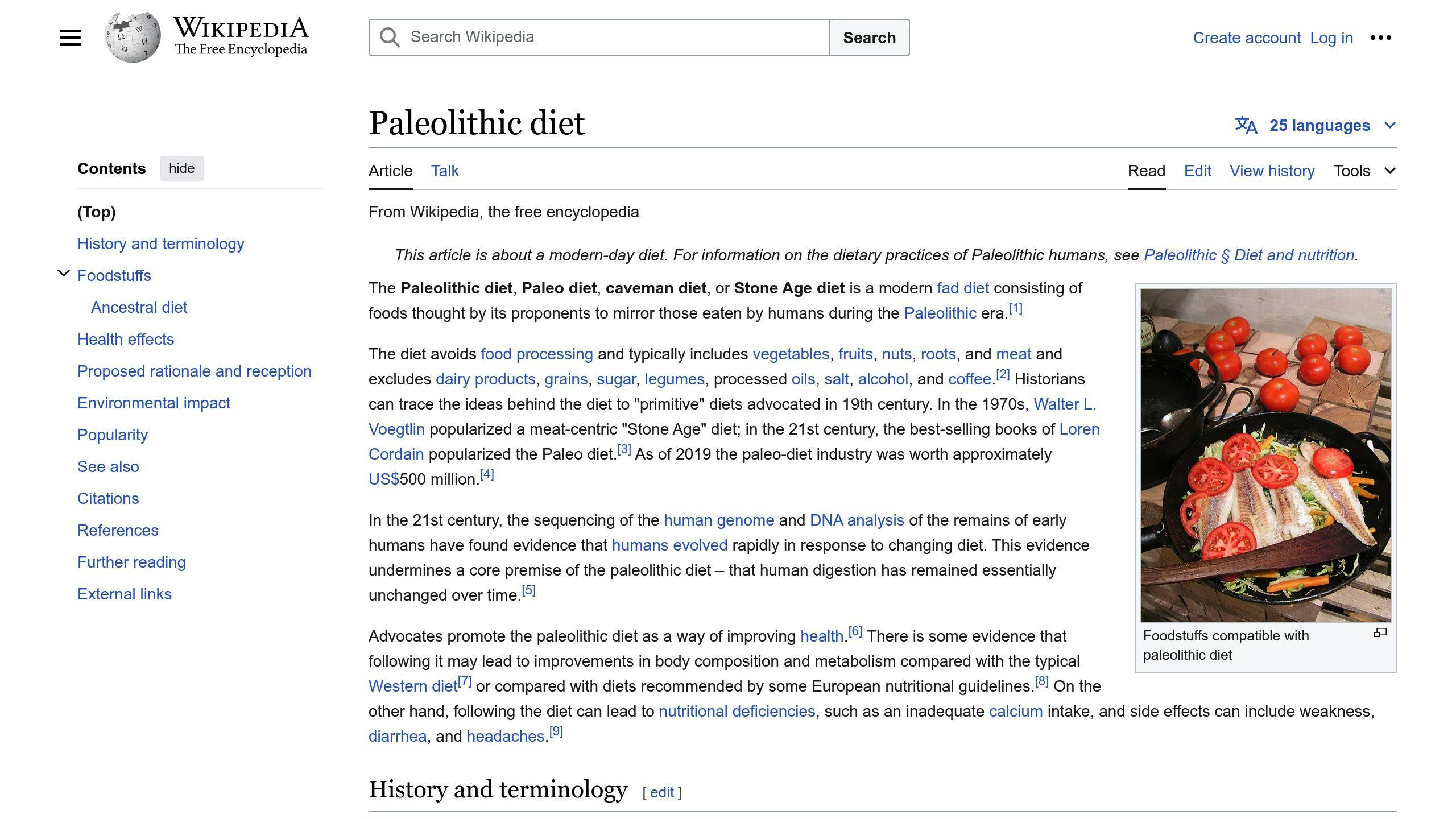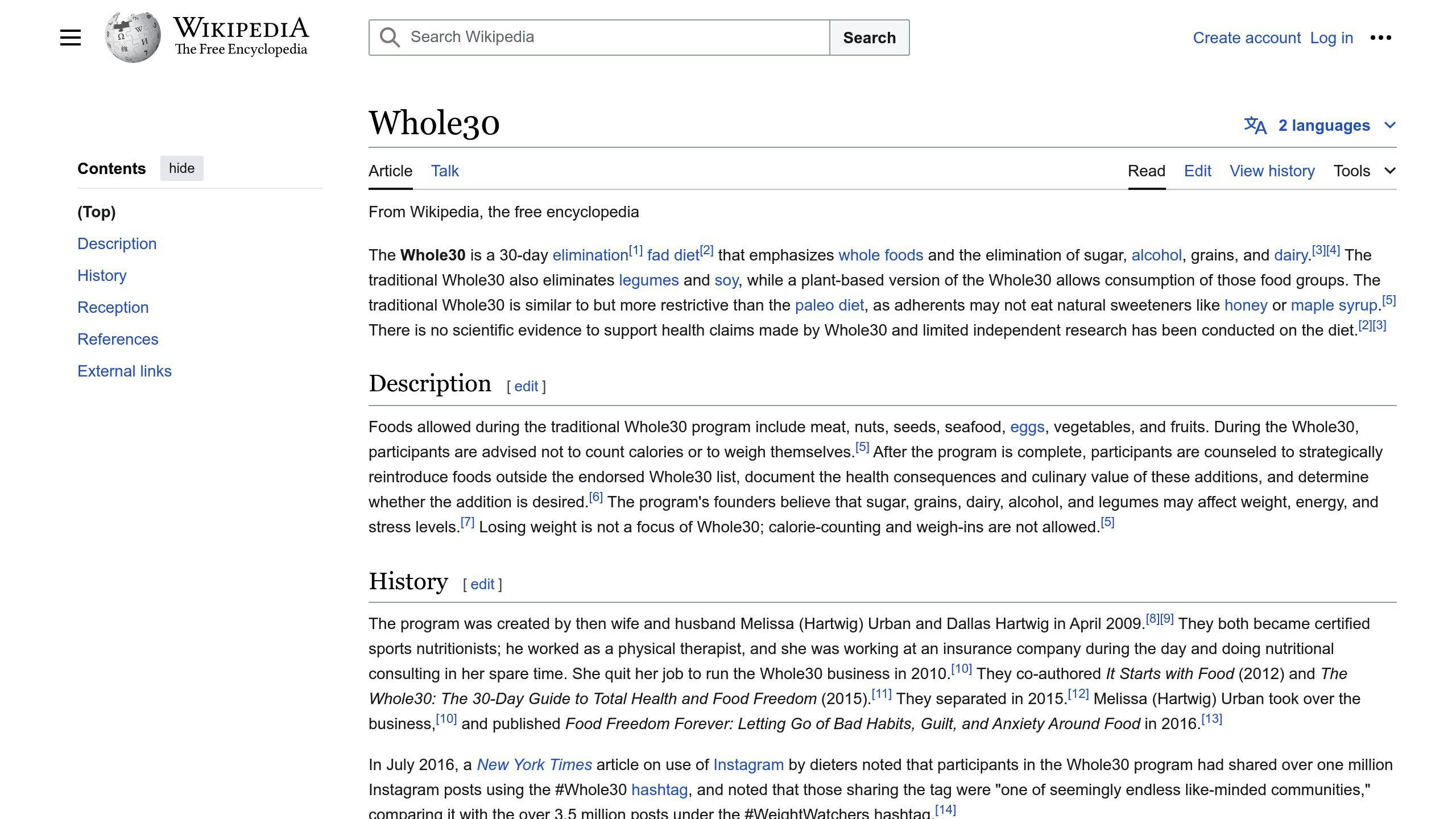The Paleo and Whole30 diets are both focused on whole, unprocessed foods, but they have distinct approaches and restrictions:
-
- Excludes grains, dairy, legumes, and processed foods
- Allows natural sweeteners like honey and maple syrup
- A long-term lifestyle approach to eating
-
- 30-day program that eliminates added sugars, artificial sweeteners, grains, dairy, legumes, and processed foods
- Designed to identify food sensitivities and reset healthy eating habits
- More restrictive than Paleo, but only for a limited duration
Quick Comparison
| Criteria | Paleo Diet | Whole30 Diet |
|---|---|---|
| Duration | Long-term | 30 days |
| Grains | Not allowed | Not allowed |
| Dairy | Not allowed | Not allowed |
| Legumes | Not allowed | Not allowed |
| Added Sugars | Allowed (e.g., honey, maple syrup) | Not allowed |
| Alcohol | Not allowed | Not allowed |
For meal prep services, understanding these differences is crucial to creating tailored meal plans that cater to clients' specific dietary needs and goals. Key considerations include accommodating food restrictions, sourcing high-quality ingredients, managing costs, and providing educational resources and personalized support.
Paleo Diet Guidelines

Paleo Eating Principles
The Paleo diet focuses on eating whole, unprocessed foods that were available to our ancestors during the Paleolithic era. This diet emphasizes consuming foods rich in nutrients and fiber, while avoiding foods high in sugar, salt, and unhealthy fats. The core principles of the Paleo diet include:
- Eating whole, unprocessed foods like meats, fish, fruits, vegetables, nuts, and seeds
- Avoiding grains, dairy, legumes, and processed foods
- Focusing on lean protein sources and healthy fats
- Including a variety of colorful vegetables and fruits in your diet
- Drinking plenty of water and limiting sugary drinks
Allowed and Restricted Paleo Foods
Here is a breakdown of the types of foods that are encouraged and avoided on the Paleo diet:
| Food Category | Allowed Foods | Restricted Foods |
|---|---|---|
| Meats | Grass-fed beef, wild game, free-range chicken and eggs, wild-caught fish | Processed meats, farmed fish |
| Vegetables | Leafy greens, broccoli, cauliflower, carrots, sweet potatoes | None |
| Fruits | Berries, citrus fruits, apples, pears | None |
| Nuts and Seeds | Almonds, walnuts, chia seeds, flax seeds | Peanuts, soybeans |
| Healthy Fats | Avocado, olive oil, coconut oil | Vegetable oil, canola oil, soybean oil |
| Condiments | Salt, pepper, garlic, ginger | Sugar, honey, artificial sweeteners |
| Grains | None | Wheat, barley, rice, quinoa |
| Dairy | None | Milk, cheese, yogurt |
| Legumes | None | Beans, lentils, peanuts |
| Processed Foods | None | Packaged snacks, sugary drinks, refined sugars |
By understanding the principles and guidelines of the Paleo diet, meal prep services can create tailored plans that cater to the specific needs and goals of clients following this diet.
Whole30 Diet Rules

The Whole30 diet is a 30-day eating plan that helps you develop a healthier relationship with food and improves your overall well-being. Unlike the Paleo diet, which is a lifestyle approach, Whole30 is a structured program with specific rules and guidelines.
Whole30 Program Goals
The primary goal of Whole30 is to help you identify and eliminate food groups that may be causing inflammation, digestive issues, or other health problems. By removing these foods from your diet for 30 days, you can experience improved energy levels, better digestion, and a reduction in chronic symptoms.
Whole30 Food Restrictions
For 30 days, you must eliminate the following food groups from your diet:
| Food Group | Restricted Foods |
|---|---|
| Added Sugars | Natural sweeteners like honey and maple syrup |
| Grains | Wheat, barley, rice, and quinoa |
| Legumes | Beans, lentils, and peanuts |
| Dairy | Milk, cheese, and yogurt |
| Processed Foods | Packaged snacks and sugary drinks |
| Other | Carrageenan, sulfites, and MSG |
By following these restrictions, you can experience the full benefits of the Whole30 program and gain a better understanding of how different foods affect your body.
Paleo vs Whole30 Meal Plans
When it comes to meal prep services, understanding the differences between Paleo and Whole30 diets is crucial for catering to clients with specific dietary needs. While both diets focus on whole, unprocessed foods, they have distinct approaches to food restrictions, duration, and health goals.
Duration and Flexibility Differences
The Paleo diet is a long-term eating plan that focuses on whole, nutrient-dense foods. In contrast, the Whole30 diet is a 30-day program designed to help individuals identify and eliminate food groups that may be causing inflammation, digestive issues, or other health problems. The strict 30-day duration of Whole30 allows individuals to experience the benefits of a reset diet, whereas the Paleo diet offers more flexibility in terms of food choices and meal planning.
Food Restriction Comparison
| Food Group | Paleo Diet | Whole30 Diet |
|---|---|---|
| Sweeteners (e.g., Honey, Maple Syrup) | Allowed | Not Allowed |
| Grains | Not Allowed | Not Allowed |
| Dairy | Not Allowed | Not Allowed |
| Legumes | Not Allowed | Not Allowed |
| Alcohol | Not Allowed | Not Allowed |
As shown in the table above, both diets eliminate grains, dairy, and legumes from the diet. However, the Paleo diet may allow for natural sweeteners like honey and maple syrup, whereas Whole30 restricts all added sweeteners.
Diet Philosophies and Health Goals
The underlying philosophies and health goals of Paleo and Whole30 diets also differ. The Paleo diet aims to promote a balanced and sustainable eating plan that focuses on whole, nutrient-dense foods, with the goal of improving overall health and well-being. In contrast, the Whole30 diet is designed to help individuals identify and eliminate food groups that may be causing inflammation, digestive issues, or other health problems, with the goal of improving energy levels, digestion, and overall well-being. While both diets share similar health goals, the Paleo diet takes a more holistic approach, whereas Whole30 focuses on a short-term reset diet.
sbb-itb-3666cb4
Meal Prep Service Considerations
Meal prep services catering to Paleo and Whole30 diets must consider various operational aspects to ensure successful meal planning and client satisfaction.
Accommodating Dietary Needs
To accommodate Paleo and Whole30 clients, meal prep services must adjust their menus to comply with the specific dietary restrictions of each diet. This may involve creating separate menus or modifying existing ones to exclude restricted food groups.
| Diet | Menu Adjustments |
|---|---|
| Paleo | Exclude grains, dairy, and legumes; include dishes like grilled salmon with roasted vegetables and sweet potato |
| Whole30 | Exclude grains, dairy, legumes, and added sugars; include dishes like chimichurri grilled steak with roasted broccoli and cauliflower mash |
Sourcing Ingredients and Managing Costs
Meal prep services must also consider the impact of Paleo and Whole30 diets on ingredient sourcing and cost management. Since both diets emphasize whole, unprocessed foods, meal prep services may need to source higher-quality ingredients, which can increase costs.
Cost Management Strategies
- Explore alternative suppliers
- Negotiate prices
- Optimize menu planning to minimize waste and reduce costs
Educating and Supporting Clients
Effective client education and support are crucial for meal prep services catering to Paleo and Whole30 clients.
Education and Support Strategies
- Provide educational resources (e.g., blog posts, videos, workshops) to help clients understand the principles of each diet
- Offer personalized support (e.g., nutrition counseling, meal planning guidance) to help clients stay on track and achieve their health goals
Conclusion: Successful Paleo and Whole30 Meal Prep
In conclusion, understanding the key differences between Paleo and Whole30 diets is crucial for meal prep services seeking to cater to clients following these diets. By recognizing the distinct guidelines and principles of each diet, meal prep services can create personalized meal plans that meet the specific needs of their clients.
Key Dietary Differences Summary
The Paleo diet focuses on whole, unprocessed foods, excluding grains, dairy, and legumes, while the Whole30 diet is a more restrictive 30-day program that eliminates added sugars, artificial sweeteners, and processed foods.
| Diet | Key Principles |
|---|---|
| Paleo | Focus on whole, unprocessed foods; exclude grains, dairy, and legumes |
| Whole30 | 30-day program; eliminate added sugars, artificial sweeteners, and processed foods |
Recommendations for Meal Prep Services
To successfully integrate Paleo and Whole30 diets into their portfolios, meal prep services should:
- Develop separate menus for each diet, taking into account the specific food restrictions and guidelines
- Source high-quality, whole ingredients to ensure compliance with both diets
- Provide educational resources and personalized support to help clients understand the principles of each diet and achieve their health goals
- Offer flexible meal planning options to accommodate clients with varying dietary needs and preferences
By following these recommendations, meal prep services can effectively cater to clients following Paleo and Whole30 diets, promoting healthy eating habits and supporting their clients' wellness journeys.
FAQs
What diet is closest to Whole30?
The Paleo diet is similar to Whole30. Both diets focus on whole foods and can help with weight loss. However, they may also limit your nutrient intake and be difficult to follow long-term.
Here's a comparison of the two diets:
| Diet | Key Principles |
|---|---|
| Whole30 | 30-day program; eliminate added sugars, artificial sweeteners, and processed foods |
| Paleo | Focus on whole, unprocessed foods; exclude grains, dairy, and legumes |
Both diets have similar benefits, but they also have some differences. It's essential to understand the principles of each diet to choose the one that best fits your needs and goals.



